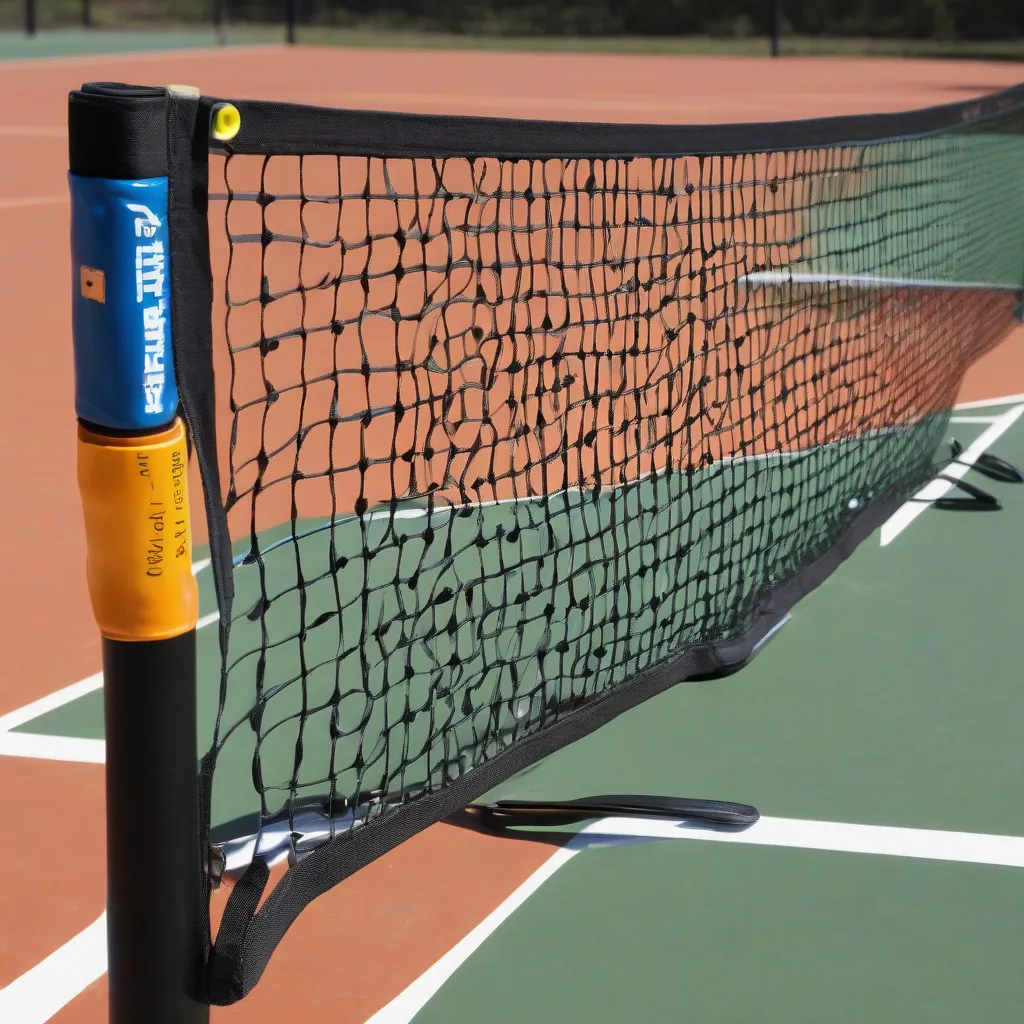Table of Contents
Introduction to Pickleball Net Height
Understanding the correct pickleball net height is crucial for ensuring fair play and optimal performance. Whether you’re a beginner or a seasoned pro, knowing the standard net height and how to set it up correctly can significantly impact your game. This guide covers everything you need to know about pickleball net height, including official measurements, setup tips, and the importance of proper net height in gameplay.
Standard Pickleball Net Height
The official pickleball net height is 36 inches at the sidelines and 34 inches at the center. This slight dip in the middle is designed to accommodate the dynamics of the game and ensure consistent play. The net spans a total length of 22 feet, covering the entire width of the court, which measures 20 feet wide.
 Pickleball Net Height
Pickleball Net Height
Why Net Height Matters
Proper net height is essential for several reasons:
- Fair Play: Adhering to the official net height ensures that all players compete under the same conditions, maintaining the integrity of the game.
- Consistent Performance: A correctly set net allows for consistent ball bounce and shot execution, crucial for both practice and competitive play.
- Reduced Injury Risk: Proper net height can prevent players from making excessive jumps or swings, reducing the risk of injuries.
How to Measure and Set Up the Net
Setting up your pickleball net to the correct height is straightforward with the right tools. Here’s a step-by-step guide:
1. Gather Your Tools
You’ll need a measuring tape or a net height measurement stick specifically designed for pickleball. A level surface and sturdy net posts are also essential.
2. Measure the Sidelines
Start by measuring the height of the net at the sidelines, ensuring it is 36 inches high. Adjust the net tension to achieve this height if necessary.
3. Measure the Center
Next, measure the net height at the center, ensuring it dips to 34 inches. Most pickleball nets have a center strap that can be adjusted to achieve the correct height.
4. Check the Tension
Ensure the net is taut but not overly tight, as this can distort the height and affect play. The net should be firm enough to bounce the ball consistently.
Adjusting for Different Playing Surfaces
Whether you’re playing on an indoor court, a concrete surface, or a temporary setup in your backyard, it’s important to maintain the correct net height:
Indoor Courts
Indoor courts typically have permanent net posts, making it easier to maintain the correct height. Regularly check the net tension and height, especially if the court is used for multiple sports.
Outdoor Courts
Outdoor surfaces can be uneven, so it’s crucial to measure the net height at both the sidelines and the center each time you set up. Use a portable net system designed for easy adjustment.
Backyard Setups
For casual play in your backyard, ensure you have a flat surface and use a reliable net system. Even for recreational games, maintaining the correct net height enhances the quality of play.
Impact of Net Height on Gameplay
The height of the net influences various aspects of gameplay:
Shot Execution
Proper net height allows players to practice and execute shots consistently, improving accuracy and technique. For instance, the correct height is essential for perfecting serves and volleys.
Ball Bounce
A net set too high or too low can alter the ball’s bounce, affecting rallies and overall game dynamics. Maintaining the standard height ensures predictable ball behavior.
Player Strategy
Players develop strategies based on the standard net height. Any deviation can disrupt their game plan, making it crucial to adhere to the official measurements for competitive play.
Common Net Height Mistakes and How to Avoid Them
Avoiding common mistakes can help you maintain the correct net height:
1. Over-Tightening the Net
While it’s important to keep the net taut, over-tightening can raise the center height and affect play. Adjust the tension until the net is firm but still compliant with the 34-inch center height.
2. Ignoring Surface Irregularities
Outdoor courts can be uneven, causing inaccurate height measurements. Always measure the net height at multiple points to ensure consistency.
3. Using Improper Tools
Using a measuring tape designed for other sports can lead to incorrect measurements. Invest in a pickleball-specific measurement tool for accuracy.
Resources for Further Learning
For more detailed information on pickleball net height and proper setup, explore these valuable resources:
- Visit the USA Pickleball Association (USAPA) for comprehensive guides and tips.
- Explore instructional videos and articles on Pickleball Central.
- Check out detailed reviews and tutorials on Pickleball Portal.
- Learn from top players and coaches on PickleballMAX.
Conclusion
Maintaining the correct pickleball net height is crucial for fair and consistent gameplay. By following the guidelines provided in this article, you can ensure that your net is set up correctly, whether you’re playing casually or in a competitive setting. Proper net height enhances shot execution, ball bounce, and player strategy, contributing to a better overall pickleball experience. Use this guide to refine your net setup skills and enjoy the game to its fullest.
Frequently Asked Questions
- What is the standard pickleball net height? The official net height is 36 inches at the sidelines and 34 inches at the center.
- Why is net height important in pickleball? Proper net height ensures fair play, consistent performance, and reduces the risk of injuries.
- How do I measure the net height accurately? Use a measuring tape or a net height measurement stick, and ensure the net is 36 inches at the sidelines and 34 inches at the center.
- What tools do I need to set up the net correctly? You need a measuring tape or a net height measurement stick, and sturdy net posts. A level surface also helps ensure accurate measurements.
- Where can I find more information on pickleball net height? Visit the USA Pickleball Association, Pickleball Central, Pickleball Portal, and PickleballMAX websites for comprehensive guides and tips.